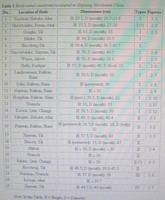Jianjun Mei
The Metal Cauldrons Recovered in Xinjiang, Northwest China
In: Newsletter on Steppe Archaeology, no. 13, 2002. márc. (Tokió)
Xinjiang region, west of Gansu and Qinghai provinces in Northwest China, is well known as an important crossroads on the ancient Silk Road. It has been widely recognized as a pivotal region for understanding early cultural interaction between China and Central Asia (Shui 1993; Di Cosmo 1996). One of the important signs for cultural changes in Xinjiang from the early first millennium BC is the appearance of metal cauldrons, which was clearly related to the rise of nomadic way of life on the Eurasian steppe. In this short article, a brief survey of the metal cauldrons recovered in Xinjiang and the analysis results of five cauldrons are presented.
1. The finds of metal cauldrons in Xinjiang
So far more than two dozens of metal cauldrons have been found in Xinjiang, and most of them can be dated to the mid-first millennium BC (Table 1). Except for two examples that were found in the mountain areas of southern Xinjiang, the majority of cauldrons were recovered in the areas north of the Tian Shan mountains, such as Yili, Balikun and Altai (Fig. 1; Wang & Qi 1995: 277-94; Gong 1997: 16; Yue, et al. 1999: 252, 270). These areas have vast pastureland suitable for grazing sheep, cattle, horses and other animals. The concentrated distribution of cauldrons in northern Xinjiang shows the close link between the appearance of metal cauldrons and the rise of nomadic way of life in the region during the early first millennium BC.
According to their handle and foot designs, these cauldrons can be roughly classified into four types. Type I is characterized by a pair of rounded handles standing upright on the rim of the mouth (Fig. 2). Type II is distinguished by a pair of handles standing obliquely on the shoulder of the vessel (Fig. 3: 1-5). Type III is a developed form of Type I, with two handles decorated with "mushroom" design (Fig. 3: 6). This type is generally dated to the 2nd-4th centuries AD, being much later than the other types (Erdy 1995: 45-46). In contrast to the above three types that have only a single stand, Type IV has three feet and can thus be called 'tripod cauldron' (Fig. 3: 7).

A few observations on the cauldron finds in Xinjiang may be made here. First, while these cauldrons can be classified into four major types, their sizes and some details of shapes and decorations show quite a large range of variants, and one cannot find two identical specimens. This suggests that the sources for these cauldrons were likely diverse and localized. Second, the Type I cauldrons from Xinjiang are comparable in form to those found in North China, Mongolia and southern Siberia, which have been dated roughly to the 8th-4th centuries BC (Liu 1987: 62; Chlenova 1994: 506; Takahama 1994:1-6). The dates for the Xinjiang specimens are likely within a similar chronological range, only the cauldron with a pierced stand from Fuyun in Altai (Fig. 2: 2) should be considered within a later date.
Third, the cauldrons of Type II and Type IV typologically resemble those found in the Semirechiye region in Kazakhstan and Kirghizia, which have been attributed by Russian scholars to the Saka culture of the 7th-4th centuries BC (Akishev & Kushayev 1963: 111) or 5th-3rd centuries BC (Bernshtam 1949: 353-4, 1952: 47). This resemblance suggests that the Xinjiang specimens could probably be considered within the Saka context and dated to the 7th-3rd centuries BC. Among the Type II cauldrons, the one from Biliuhe in Qitai is worthy of special attention. It is featured with a pair of "three-legs" handles standing horizontally on the shoulder (Fig. 3: 5). Cauldrons with this characteristic design of handles were also recovered in southern Siberia. It seems very probable that the Xinjiang specimen was related to those similar pieces in southern Siberia in some way.
Fourth, only one specimen of Type III cauldrons has been recovered so far in Xinjiang (Fig. 3: 6). It has many close parallels in Eastern Europe, revealing the existence of a long-distant connection. Erdy (1995: 46) suggests that the Xinjiang specimen is an early local development in the vicinity of the Altai' in the 2nd century AD rather than the one that was returned from Europe later. Finally, except for a few decorated with simple geometric patterns such as lines and triangles, most cauldrons from Xinjiang are plain on surface. This shows a clear contrast to those heavily decorated Scythian cauldrons of the 7th-4th centuries BC from western Eurasia (Yukishima 1995; Jacobson 1995: 189-92).